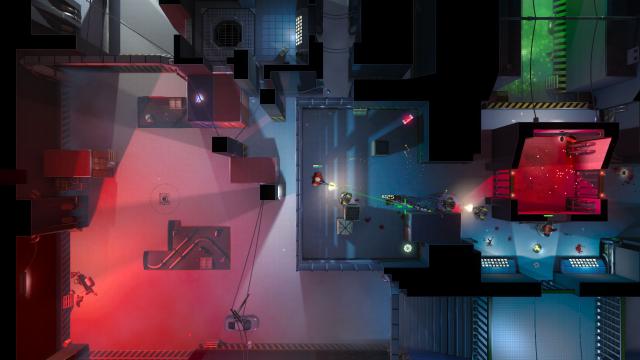If you look at a list of the Steam games with the all-time highest concurrent player counts, you’ll mostly see the usual suspects: PUBG, CSGO, Fallout 4, Grand Theft Auto 5 and so on. An outlier, however, hovers on the outskirts of the top 10. It’s called Geneshift, and it got there because of the hard work of one man — and also a relentless army of bots.
The bots, to be clear, did not belong to Geneshift creator Ben Johnson, who’s spent nine years on his top-down GTA 2-inspired multiplayer game, which came out in early access in May 2017. The bots were made by people who use them to idle in games that drop Steam trading cards, which bot users then sell on the Steam marketplace to turn a cash profit.
It’s a known issue that Valve has tried to curtail, but with only marginal success.
The first time the bot swarm turned its heaving mass of electric eyes on Geneshift was due to a confluence of events. On December 16 of last year, Johnson made his game free-to-keep for 24 hours as part of a promotion to build a player base for a new battle royale mode.
It isn’t uncommon for bots to idle on games that lop off their price tags, but Johnson posted about his promotion on Reddit. The thread was massively successful, gaining 66.5k upvotes.
This turned Geneshift into a lightning rod, according to a follow-up post by Johnson, that sent more than 200,000 bots in the game’s direction. There were so many bots that Valve temporarily disabled its trading cards altogether.
Prior to that day, Geneshift was peaking at player counts of less than 10. Overnight, it became one of the most concurrently-played Steam games ever, entering the top 10 with a peak of 213,183.
At the time, Johnson was more surprised than anything.
“[This] somehow placed Geneshift on the top 10 leaderboard for the most played games on Steam… OF ALL TIME!” he wrote in a post on Steam last December. “This is totally ridiculous and again, these are not real players, but as a single dev this just blows my mind.”
Since then, Geneshift has fallen out of the top 10, albeit only narrowly, landing just one spot behind For Honor’s 216,499.
However, the bots have returned on multiple occasions. To the befuddlement of Johnson and Geneshift’s player base, the game’s trading cards weren’t re-enabled until January 14, at which point — even without any Reddit thread or other attention to speak of — its player count shot through the roof again.
This time, it jumped from 20-50 concurrents to a peak of 114,920. It was less than before, but still a boatload by most measures of both boats and loads.
Since then, the bot swarm has dissipated — for the most part. In the past few days, the game’s seen more unusual activity. Before January 29, Geneshift’s player count had been hovering around 350 concurrents. Since then, it’s jumped up to 1100-1600. It’s likely that bots are still involved — just hundreds of them, instead of hundreds of thousands.
At this point, Johnson is mostly happy to peacefully coexist with the remaining bots, though he does have some concerns. On the upside, his December promotion and the furore that followed brought in thousands of new real players, and he told Kotaku over email that the community is now “more active than ever before”.
Steam’s algorithm is a temperamental beast, so he’s worried the bots might leave a lasting impact on how it perceives his game.
“The algorithm will provide exposure and recommend games based on a number of factors, such as rating, refunds and average play-time,” Johnson said.
“The play-time one is the one I’m concerned about, as the median play-time now will forever be locked at exactly 5.1 hours due to the sheer volume of bots who idled the game for exactly that amount of time. Whether this is a good thing or not, I’m not sure.”
At this point, there’s not really much Johnson can do about it. Having Valve disable trading cards again, he said, would only upset his customers, and while it feels “messy” to him having all these bots just chilling in his game, them’s the breaks.
“Ideally Valve could somehow distinguish between real players and only disable the cards for the bots,” he said. “But I’m assuming they can’t do this or they’d have done it already.”
On the whole, Johnson thinks this episode has done more good than bad for Geneshift. He’s gotten an influx of new players and plenty of useful feedback that he’ll be able to use to improve the game over the next few months. He’s also great fun at parties now.
“The bot swarm also gives me a fun pub story,” he said. “I can jokingly claim to have had more ‘players’ than PUBG at one point in time.”

Comments
2 responses to “Trading Card Bots Sent A Small Indie Game Rocketing Up The Steam Charts”
If majority cards were tied to certain conditions / “achievements” other than play time then the system couldn’t be milked so hard.
Like beat a certain level or get a certain score nets you a random card.
Which is the exact opposite of how Valve run the trading card system so I don’t see it happening.
Basically yet again a problem with Steam is solely Valve’s fault, it’s been around for years and nothing has been done…sums them up pretty well.